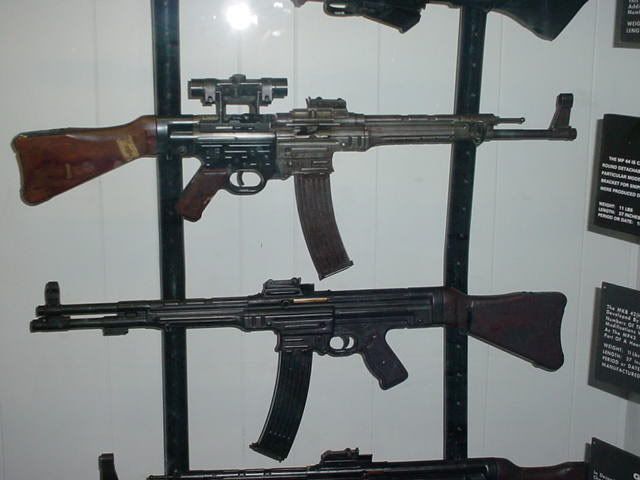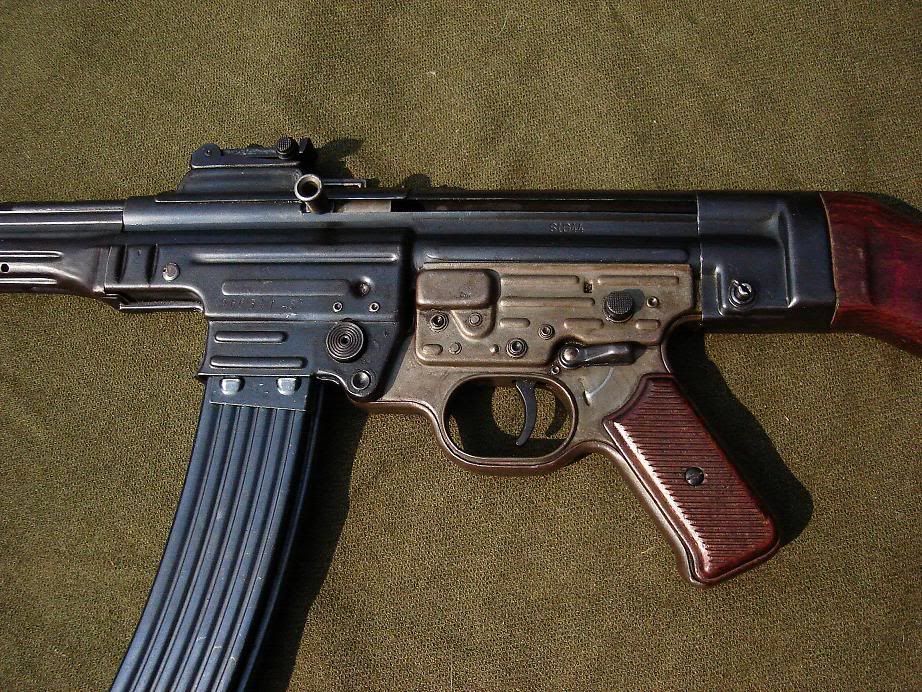Sturmgewehr -- The Storm Rifle!

German development of assault rifle concept went back to the 1930's, with some very innovative designs being tested as early as 1935, two years after the Nazi Party came to power. Polte and Geco were developing intermediate power cartidges, two that showed the most promise were a 7.62x38mm and a 7.92x33mm. It was decided to concentrate on the 7.92x33mm cartridge.
It's not hard to imagine where the Soviets got the idea and or plans for what became their 7.62x39mm cartridge. Many people find it hard to believe that the Soviets would devote the time, people, and materials needed to develop a wholly new cartridge for a weapon system that hadn't even been invented yet, while still fighting off the German invasion. The Soviets had a well developed spy network in Germany which fed many technical and military secrets to them. The Soviets type classified the 7.62x39mm cartridge in 1943. The first rifle that actually fired it, the SKS, wasn't even on the drawing board yet.
Schmeisser was one of the most brilliant small arms designers that the Germans had, primarily working for Erma and Haenal. He was one of the main men responsible for the creation of the first true submachine gun in WWI, the MPi-18, and the first modern assault rifle, starting with the early MKb-42 (H) , which fired from an open bolt in both semi and full auto. The MKb-42(H) used a bolt carrier with an attached gas piston and tilting bolt assembly, which would be used in the MP-43/MP-44/StG-44, although now firing from a closed bolt. This system was more reliable than the competing Walther MKb-42(W), which used a gas piston that encircled the barrel, like the earlier Gewehr 41(W). If the jacket surrounding the barrel took a hit or became dented, it would restrict the movement of the piston.
About 10,000 of the Haenel "machine carbines" were produced between 1942 and early 1943, with many being sent to the East Front for field testing against the Soviets. Proof of concept was secured, and improvments were made, such as moving the gas port further back from the muzzle and modifying the weapon to fire from a closed bolt. At this point in the war, Hitler didn't want any more new rifles, he wanted an increase in production of sub machine guns, so the new weapon was type classified as the MP-43, or Machine Pistol 43. Mass production of the new weapon was undertaken, in secret, and most of the new weapons were supplied to the Waffen SS for use on the Eastern Front. The Wehrmacht and Falschirmjaegers of the Luftwaffe also received them and used them to good effect.
Small changes to enhance production were done and the weapon was retyped the MP-44, and finally, once Hitler was made aware of the weapon and it's effectiveness, he approved it and for propaganda purposes the new "Wunderwaffe" was called the Sturmgewehr, or Storm Rifle (assault rifle). The weapons production and procurement in Nazi Germany was a tangled web of surprising inefficiency and confusion. It wasn't uncommon to see Sturmgewehrs that were produced late in 1945 to be stamped MP-43.
Earlier guns typically had threaded muzzles with a protective nut over the threads, and later 1945 guns might have plain muzzles. A number of devices were designed to allow the Sturmgewehr to fire around corners, or out of an armored vehicle, by attaching a tube at the muzzle to catch and direct the bullets at an angle.
The Sturmgewehr's operating mechanism is both evolutionary and revolutionary. The one piece bolt carrier and long stroke gas piston is similar to the M1 Garand, and the tilting lock bolt is similar to the Soviet Tokarev SVT-38 and SVT-40, in concept but not in execution. The recoil/buffer spring is contained in the wooden buttstock. This was revolutionary but flawed in execution as the spring is traveling in the wooden stock without a metal tube to guard and guide the spring. If the wooden stock becomes damaged, shrinks or swells due to being submerged in water or moisture, it can take the weapon out of action. The recoil/buffer spring and the ejection port dust cover would be later used by Stoner on the AR-10 and later by Sullivan on the AR-15. The receiver is a stamped steel shell, much like the first AK-47, the Type I, and the later, improved, AKM. The barrel is housed in a trunnion that is attached to the inside of the receiver. The fire control group is housed in a lower trigger pack that is attached to the receiver by a permanent pin up front and rear push pin that attaches the buttstock assembly, receiver, and trigger pack together......anyone familiar with the HK series of weapons can easily see the lineage.
Sturmgewehrs use a separate safety and selector. The safety is a lever on the left side of the weapon, above the trigger group, much as what would appear later on the FN FAL, AR-10/AR-15 and HK G3/33. The selector is a push through button above the safety. This required a dedicated movement to enable full auto fire.
The 7.92x33mm cartridge, also known as 8mm kurz (German for "short"), fires a 125 gr. bullet at about 2200 fps - 2300 fps. That's slightly less powerful than the 7.62x39mm Soviet M43 cartridge, but it's definitely adequate for use out to 300m-400m. That power level combined with the weight of the Sturmgewehr (11.5 lbs) make for an extremely controllable weapon. As LAV says, you can "walk the dog" with it.
Hugo Schmeisser was initially captured by the US Army, but was released after a few weeks. When the Soviets occupied Suhl, they grabbed him and he was shipped back to the Soviet Union to work on their small arms programs at Izvehsk, just as other German engineers and scientists were pressed into service by the Soviets on their nuclear and space program. He was released from the Soviet Union in 1952 to return to what was now the DDR, where he died in 1953.
It doesn't take a rocket scientist to see that while the AK-47 isn't a clone of the Sturmgewehr operationally (it's actually closer to the M1 Garand in operation), it is an exact clone of the German concept of the assault rifle.
This is a MKb-42(H) that is in the Aberdeen US Army Ordnance Museum. The weapon above it is a Sturmgewehr with a 1.5x optic attached.

Early weapons were blued, but Sturmgewehrs were finished in phosphate (Parkerized) as well as left in the white or with a clear phosphate finish. It's not at all uncommon to see a Sturmgewehr sporting different finishes on it's different components, as they were assembled with parts from various subcontractors who all finished their parts differently.
This particular Sturmgewehr belongs to a member of my club. It's an "Amnesty Register" transferrable machine gun. Brought back from WWII by a GI and finally, legally registered during the amnesty of 1968. Notice the mix of finishes and features.















No comments:
Post a Comment